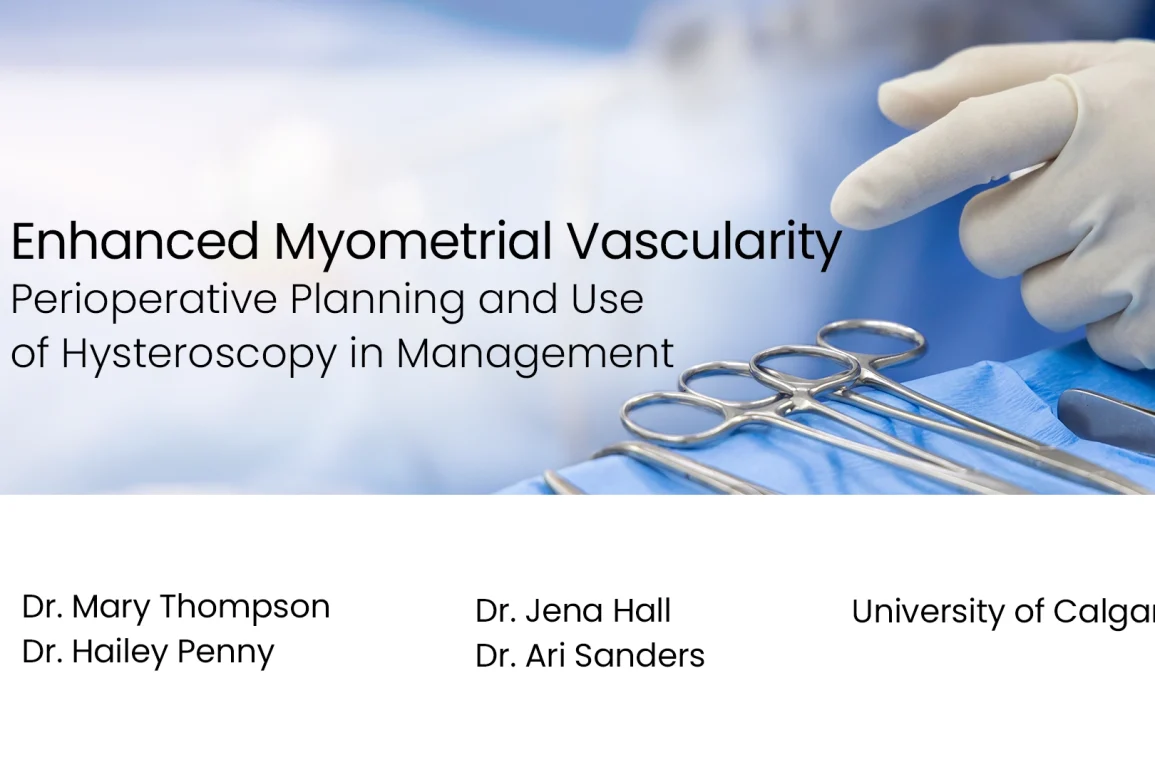Table of Contents
- Procedure Summary
- Authors
- Youtube Video
- What is Enhanced Myometrial Vascularity?
- What are the Risks of Enhanced Myometrial Vascularity?
- Video Transcript
Video Description
A surgical approach to managing enhanced myometrial vascularity with perioperative planning and hysteroscopy, focusing on bleeding risk and fertility outcomes.
Presented By
Affiliations
University of Calgary
Watch on YouTube
Click here to watch this video on YouTube.
What is Enhanced Myometrial Vascularity?
Enhanced Myometrial Vascularity (EMV) is an acquired uterine vascular abnormality characterized by abnormal high-flow connections between arteries and veins within the myometrium. Key points include:
-
Definition and Cause: EMV represents an acquired form of uterine arteriovenous malformation (AVM), often developing after pregnancy-related events, uterine procedures (such as dilation and curettage), infection, or retained products of conception.
-
Diagnosis: Transvaginal ultrasound with colour Doppler is the preferred imaging modality. Hallmarks include focal areas of intense vascularity extending into the myometrium, a colour mosaic pattern, and high peak systolic velocity. Differentiating EMV from retained products is critical, as EMV shows true myometrial extension.
-
Clinical Presentation: Patients may present with heavy or recurrent uterine bleeding, sometimes severe enough to cause anaemia or haemodynamic instability. Some cases are discovered incidentally during evaluation for retained products or persistent postpartum bleeding.
-
Management Options: Treatment is individualised based on bleeding severity, fertility goals, and imaging findings. Options range from conservative observation and medical therapy to uterine artery embolization or surgical intervention such as hysteroscopic resection or hysterectomy in refractory cases.
What are the Risks of Enhanced Myometrial Vascularity?
EMV carries significant risks primarily related to its high-flow vascular nature. Potential complications include:
-
Severe Haemorrhage: Sudden, heavy uterine bleeding can lead to hypovolemic shock and may require transfusion, emergent embolization, or hysterectomy.
-
Inaccurate Diagnosis: Misidentifying EMV as retained products can lead to blind curettage, which increases the risk of catastrophic bleeding.
-
Procedure-Related Complications: Interventions such as hysteroscopic resection or uterine artery embolization can result in uterine perforation, infection, or postoperative adhesions.
-
Fertility Impact: Embolization or extensive surgery may compromise future fertility or lead to intrauterine scarring.
-
Recurrence or Persistence: Incomplete treatment may allow persistent vascular shunting and ongoing risk of bleeding.
Careful imaging, multidisciplinary planning, and readiness for rapid haemorrhage control are essential to safely manage patients with enhanced myometrial vascularity.
Video Transcript:
In this video, we will discuss enhanced myometrial vascularity diagnoses, focusing on perioperative planning and the use of hysteroscopy in management. After this video, viewers will be able to define enhanced myometrial vascularity and understand the associated risk factors, to recognise the potential of hysteroscopy in its management, and to understand the importance of perioperative planning.
An arteriovenous malformation is defined as abnormal anastomoses between arteries and veins leading to focal, torturous, high-flow vascular lesions. Uterine AVMs are either congenital, which are extremely rare, or acquired, now referred to as uterine enhanced myometrial vascularity or EMV.
The prevalence of EMVs is roughly 1.5 to 6.3%, and commonly occur in the context of previous uterine procedures, pregnancy-related complications, or other causes, such as infection. In our experience, EMVs often occur in the context of retained products of conception with underlying adenomyosis or infection, secondary to the increased vascularity with the retained products acting as a focal point.
Historically, the gold standard for diagnosis was angiography, however transvaginal ultrasound with colour Doppler is now the preferred imaging modality. Ultrasound criteria for diagnosis of EMVs include tubular or vascular-like structures that display a colour mosaic, presence of focal areas of marked vascularity extending into the myometrium, high peak systolic velocity, and other specific Doppler characteristics. Of note, extension of the vascular mass into the myometrium is a key differentiating feature between a uterine EMV and retained products alone.
Options for management include conservative, medical, uterine artery embolization, and surgical. Management must be individualised based on the patient’s hemodynamic status, symptoms, clinical context, imaging findings, and desire for future fertility.
We will use the next case to demonstrate an approach to perioperative planning and the use of hysteroscopy in the management of retained products of conception suspected EMV. This case focuses on the 28-year-old G1P0, who underwent an elective D&C for therapeutic abortion at six weeks, three days gestation. She then presented postoperative day seven with retained products of conception and signs of infection.
Her ultrasound described a thickened and echogenic lesion at the uterine fundus consistent with retained products of conception. There is a focus of vascularity, which demonstrate extremely high velocity of up to 161 cm per second, and arterialized venous waveforms concerning for the presence of an AVM.
Let’s start with preoperative considerations. Step one, confirm diagnosis and management options. You can begin by discussing the case with radiology to clarify their index of suspicion, then consult IR for consideration of preoperative embolization, and finally, review management options with the patient.
Step two, if the patient wants to proceed with surgical management, appropriate consent needs to be completed. Standard surgical risks associated with hysteroscopy should be reviewed as well as case-specific risks, including placement of an intrauterine balloon, uterine artery embolization, increased risk of blood transfusion, conversion to laparotomy, and possible hysterectomy.
Step three, after obtaining consent, appropriate preoperative planning should be completed to optimise the patient and OR environment for success. Based on the degree of concern, possible preoperative considerations include a preoperative anaesthesia consult, adequate IV access, including two large bore IVs and a possible arterial line, depending on anaesthesia preference.
Preoperative blood work, including a CBC type and screen, cross match blood products on standby in the OR, and ensuring your surgical table is set up with all necessary equipment, including a diagnostic and operative hysteroscope, a resectoscope in the event electrosurgery is needed, plus or minus a laparotomy tray in the room. And finally, a dose of tranexamic acid can be given preoperatively.
Now for intraoperative considerations. A hysteroscopic approach carries the following two advantages. It allows for accurate diagnosis and safe intraoperative decision making, as well as targeted resection of the pathology. Step one, inject vasopressin at the cervico-uterine junction. Our preference is to use 10 to 20 cc of 20 units of vasopressin and 100 cc of normal saline injected on either side of the cervix.
Please note, volume, dilution, and injection sites used may vary according to surgeon preference.
Step two, use a 3 mm hysteroscope to hydrodilate the cervix to avoid blind dilation and potential vascular injury. Step three, adjust the fluid pressure to maintain a clear field and perform an inspection of the cavity. As you can see here, there is a significant amount of retained products, primarily arising from the fundus and left lateral aspect of the cavity.
Step four, remove the hysteroscope and switch to a 5 mm operative sheath. Again, hydrodilation and direct visualisation with the hysteroscope is preferred. Line dilation should only be completed, if necessary, by advancing the dilator to the internal os and no further.
Step five, use the mechanical tissue removal system to perform a targeted and gentle resection of the retained products. As you can see here, we start resection from the outermost edge and work our way circumferentially to ensure we maintain visualisation and can anticipate if increased vasculature becomes visible. Furthermore, as we near the myometrium and the base of the specimen, more targeted resection is performed, highlighting the advantage of a directed hysteroscopic resection over a blind procedure.
Step six, inspect the final cavity to ensure haemostasis. Step seven, if you have concerns with haemostasis, you can perform a bimanual massage, give uterotonics, or insert a paediatric catheter to provide tamponade. Once the case is complete, other important postoperative considerations include mitigating ongoing bleeding risk with additional doses of TXA and repeat CBCs as needed, and mitigating infection risk by following up any swab results and continuing antibiotics, as clinically indicated.
In summary, we hope the takeaway messages from this video are that, one, while EMV/AVM diagnoses are frequently overcalled based on preoperative imaging alone, it is important to understand the diagnostic criteria and risk factors that may heighten your suspicion. Two, appropriate patient counselling and preoperative preparations are critical in the event of complication. And three, a hysteroscopic approach allows for safe intraoperative decision making and targeted resection. Thank you.




